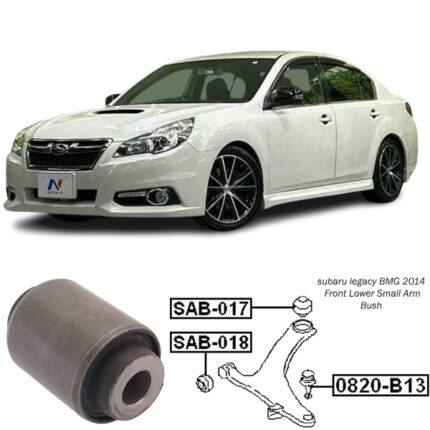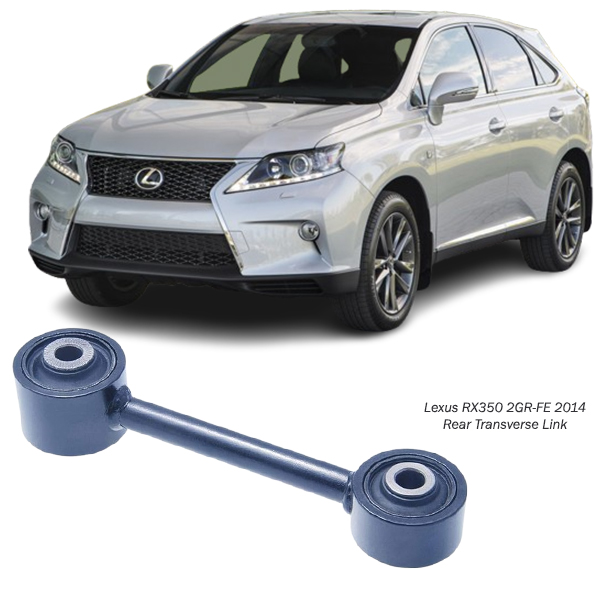-8%
Get Lexus RX350 2GR-FE 2014 Rear Rod Transverse Link 0125-GGL10R in Kenya
The rear rod transverse arm, commonly referred to as the trailing arm or rear trailing arm, is a crucial component in the suspension system of many vehicles, particularly those with independent rear suspension (IRS). This component plays a significant role in maintaining stability, handling, and ride comfort. To fully understand its function and importance, it’s essential to explore its design, role in vehicle dynamics, types, materials, maintenance, and common issues.
Design and Structure
Basic Design
The rear rod transverse arm is typically a robust, elongated component that connects the rear wheel hub to the chassis or subframe of the vehicle. Its primary function is to control the longitudinal (fore and aft) position of the wheel, while allowing for vertical movement as the suspension compresses and rebounds.
Construction Materials
Trailing arms are usually made from high-strength steel, aluminum, or other composites. Steel is commonly used due to its durability and cost-effectiveness, while aluminum and composites offer a lighter weight, which can improve vehicle performance and fuel efficiency.
Connection Points
The rear rod transverse arm has several connection points:
- Chassis Mount: This end of the arm is fixed to the chassis or subframe, typically using bushings to allow for some flexibility and to absorb vibrations.
- Wheel Hub Mount: The other end is connected to the wheel hub or spindle, enabling the wheel to move vertically.
- Additional Links: In more complex suspension designs, trailing arms may be part of a multi-link system, with additional arms and links providing extra control over wheel movement.
Function of Transverse Link;
Wheel Alignment and Control
Lateral Stability
One of the primary functions of the rear rod transverse arm is to provide lateral stability to the vehicle. It resists lateral forces that occur when the vehicle is turning, ensuring that the wheels remain in the correct alignment relative to the chassis. This helps maintain the correct camber, caster, and toe angles of the rear wheels, which are essential for proper tire contact with the road.
Suspension Geometry
The transverse arm helps in maintaining the correct suspension geometry, ensuring that the wheel moves in a controlled manner through its range of motion. This control is vital for maintaining the desired handling characteristics of the vehicle, particularly during dynamic driving conditions such as cornering, acceleration, and braking.
Load Distribution
Even Load Distribution
The transverse arm plays a crucial role in distributing loads and forces evenly across the suspension system. It helps absorb shocks and impacts from the road, transferring them to the chassis in a manner that minimizes stress on any single component. This load distribution enhances the durability and longevity of the suspension system.
Ride Comfort
By helping to absorb and distribute road impacts, the transverse arm contributes to overall ride comfort. It reduces the transmission of road vibrations and shocks to the vehicle’s cabin, providing a smoother and more comfortable ride for passengers.
Enhancing Handling and Performance
Improved Handling
The rear rod transverse arm significantly influences the handling characteristics of a vehicle. By maintaining proper wheel alignment and suspension geometry, it ensures that the vehicle responds predictably to driver inputs. This predictability is crucial for high-speed stability and precise handling, particularly during aggressive driving maneuvers.
Traction and Grip
Proper functioning of the transverse arm ensures optimal tire contact with the road surface, which is essential for maintaining traction and grip. This is particularly important during acceleration, braking, and cornering, where maximum tire contact is necessary for optimal performance.
Safety
Stability and Control
The transverse arm enhances the stability and control of the vehicle, particularly during emergency maneuvers. It helps prevent excessive body roll and maintains the alignment of the wheels, reducing the risk of loss of control. This stability is critical for avoiding accidents and ensuring the safety of the vehicle and its occupants.
Structural Integrity
The transverse arm contributes to the overall structural integrity of the suspension system. By absorbing and distributing loads, it prevents excessive stress on other suspension components, reducing the risk of failure and enhancing the reliability of the vehicle.
Types of Rear Rod Transverse Arms
Simple Trailing Arm
The simplest form of a trailing arm consists of a single, solid arm that connects the wheel hub to the chassis. This design is robust and easy to manufacture but may not provide the best handling characteristics due to its limited ability to control wheel movement.
Semi-Trailing Arm
Semi-trailing arms are angled inward toward the front of the vehicle, providing better control over camber and toe changes during suspension movement. This design offers a good balance between ride comfort and handling performance, making it a popular choice in many passenger vehicles.
Multi-Link Trailing Arm
In more sophisticated suspension systems, the trailing arm may be part of a multi-link setup, where multiple arms and links work together to precisely control wheel movement. This design allows for greater adjustability and fine-tuning of suspension characteristics, leading to improved handling and ride quality.
Maintenance and Common Issues
Inspection and Maintenance
Regular inspection of the rear rod transverse arm is crucial for maintaining vehicle safety and performance. Key areas to check include:
- Bushings: Over time, the rubber or polyurethane bushings can wear out, leading to increased play and reduced stability.
- Mounting Points: Check for any signs of wear, corrosion, or damage at the mounting points.
- Arm Integrity: Inspect the arm itself for cracks, bends, or other signs of damage.
Signs of worn out transverse link;
1. Uneven Tire Wear
One of the most noticeable signs of a worn-out rear rod transverse arm is uneven tire wear. As the control arm’s bushings or ball joints degrade, they can no longer hold the wheels in proper alignment. This misalignment causes the tires to wear unevenly, often showing more wear on one edge. Regularly inspect your tires for signs of uneven wear, as this can be an early indicator of suspension issues.
2. Clunking or Knocking Noises
A worn-out transverse arm can produce clunking or knocking noises, especially when driving over bumps or rough roads. These noises are typically caused by excessive play in the arm’s bushings or ball joints. As the components move around more than they should, they create these distinctive sounds. Pay attention to any unusual noises coming from the rear suspension, as they can indicate a problem with the control arm.
3. Poor Handling and Stability
If the rear rod transverse arm is worn, you may notice a decline in your vehicle’s handling and stability. The rear end of the car may feel loose or unstable, especially during cornering or when driving at higher speeds. This instability is due to the compromised alignment and control of the rear wheels, affecting the vehicle’s overall balance and responsiveness.
4. Excessive Vibration
A worn-out rear control arm can also lead to excessive vibration in the vehicle. This vibration is often felt in the steering wheel, seat, or floorboard and may become more pronounced at certain speeds or when driving over uneven surfaces. The vibration is usually caused by the loose or worn-out components of the transverse arm failing to properly dampen the movement of the rear wheels.
5. Squeaking or Creaking Sounds
In addition to clunking noises, you may hear squeaking or creaking sounds from the rear suspension when the transverse arm is worn out. These sounds are typically caused by the deteriorating bushings or ball joints that can no longer provide smooth and quiet operation. The noises may be more noticeable when turning or when the suspension is under load.
6. Vehicle Pulls to One Side
A vehicle that pulls to one side while driving or braking can be a sign of a worn-out rear rod transverse arm. The misalignment of the rear wheels caused by the degraded control arm can lead to uneven traction and braking forces, causing the vehicle to pull in one direction. This issue not only affects driving comfort but also poses a safety risk.
7. Visible Damage or Wear
During a visual inspection, you may be able to see visible signs of damage or wear on the rear rod transverse arm. Look for cracks, excessive rust, or deformation in the arm itself. Additionally, inspect the bushings and ball joints for signs of deterioration, such as cracking, splitting, or excessive play. Any visible damage should be addressed promptly to prevent further issues.
8. Rear End Sagging
A sagging rear end can indicate problems with the suspension components, including the rear rod transverse arm. If the arm is worn out, it may not be able to support the weight of the vehicle properly, leading to a noticeable sag in the rear. This sagging can affect the vehicle’s ride height and overall appearance.
9. Difficulty in Steering
A worn-out rear rod transverse arm can impact the vehicle’s steering response. You may experience increased difficulty in steering, particularly during low-speed maneuvers or tight turns. The compromised control of the rear wheels can affect the overall steering dynamics, making the vehicle harder to handle.
10. Suspension Warning Light
In some modern vehicles, a worn-out rear rod transverse arm may trigger a suspension warning light on the dashboard. This light indicates a problem with the suspension system that requires attention. While not all vehicles have this feature, it’s important to address any warning lights promptly and have the suspension system inspected by a professional.
Repair and Replacement
If any issues are detected during inspection, it’s essential to address them promptly. Depending on the severity of the wear or damage, the trailing arm may need to be repaired or replaced. In some cases, replacing the bushings alone can restore functionality and performance.
Follow us on Facebook for more parts.



